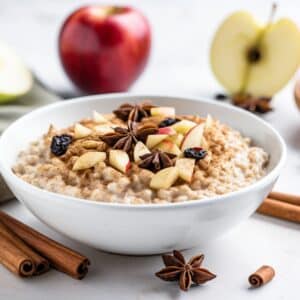
Start this simple and nutritious breakfast once you get up and while it is cooking you can prepare yourself for the day. Adding fresh apples will give you a nice crunch.
If you're searching for a breakfast option that not only tantalizes your taste buds but also keeps your blood glucose levels in check, you're in for a treat. This satisfying and nutritious breakfast combines the goodness of steel-cut oats, the natural sweetness of apples, and the warm, comforting embrace of cinnamon and vanilla extract.
Plus, we've added a touch of chia seeds and a sprinkle of raisins to enhance both flavor and nutritional value. Whether you're managing diabetes or simply looking for a nourishing morning meal, these Apple Cinnamon Breakfast Oats are a delicious choice that will energize your day while supporting your health goals.

Steel-Cut Oats: The Diabetes-Friendly Powerhouse
Steel-cut oats, also known as Irish oats, are a type of whole oat groat that has been chopped into pieces rather than rolled flat like traditional rolled oats or instant oats. These oats offer several health benefits and can be a valuable part of a diabetes-friendly diet.
Here are some key points about steel-cut oats and their benefits for people living with diabetes:
Lower Glycemic Index (GI): Steel-cut oats have a lower glycemic index compared to rolled oats or instant oats. The glycemic index measures how quickly a carbohydrate-containing food raises blood glucose levels. Steel-cut oats have a GI of around 42-55, which means they cause a slower and more gradual increase in blood glucose compared to higher-GI foods.
Lower Glycemic Load (GL): The glycemic load takes into account both the quality and quantity of carbohydrates in a serving of food. Steel-cut oats typically have a lower glycemic load compared to processed oats, as they are less processed and retain more of their natural fiber.
Rich in Fiber: Steel-cut oats are an excellent source of dietary fiber, including soluble fiber. The fiber in steel-cut oats can help slow down the absorption of glucose into the bloodstream, helping to stabilize blood glucose levels. It also promotes a feeling of fullness and can aid in weight management.
Nutrient-Rich: Steel-cut oats are a good source of essential vitamins and minerals, including manganese, phosphorus, magnesium, and iron. They also provide B-vitamins, particularly thiamin (vitamin B1), which is important for converting food into energy.
Heart-Healthy: The soluble fiber in steel-cut oats can help lower LDL (bad) cholesterol levels, which is beneficial for heart health. Managing cholesterol levels is essential for people with diabetes because they have a higher risk of heart disease.
Slow-Digesting Carbohydrates: The complex carbohydrates in steel-cut oats are slow-digesting, providing a steady release of energy and helping to avoid rapid spikes in blood glucose levels.
In summary, steel-cut oats are a nutritious choice for individuals with diabetes due to their lower glycemic index, higher fiber content, and slower-digesting carbohydrates. They can help stabilize blood glucose levels and provide essential nutrients. However, portion control and overall meal planning are crucial for managing diabetes effectively.
Be mindful of added sugars and high-calorie toppings, as they can impact blood glucose levels. Incorporating steel-cut oats into a balanced diet, along with other diabetes-friendly foods, can contribute to better glycemic control and overall health.

Unlocking the Power of Apples: Diabetes-Friendly Benefits
Apples, with their vibrant colors and crisp textures, are not only a delicious fruit but also a nutritional powerhouse that provides a multitude of health benefits, particularly for individuals living with diabetes.
These fruits are abundant in essential vitamins and minerals, including vitamin C, vitamin A, potassium, and various B vitamins like B6. Such nutrients are vital for maintaining overall health and well-being. Vitamin C supports a robust immune system, vitamin A promotes healthy skin, and potassium plays a key role in regulating blood pressure. Moreover, the presence of B vitamins, such as B6, aids in converting food into energy, a process essential for everyone, especially those managing diabetes.
One of the standout features of apples is their impressive dietary fiber content, predominantly in the form of soluble fiber called pectin. For individuals with diabetes, this fiber-rich quality is especially valuable. Soluble fiber is known to have a remarkable effect on blood glucose levels.
It works by slowing down the digestion and absorption of glucose in the digestive tract, thus preventing the rapid spikes in blood glucose levels that can be problematic for those with diabetes. By providing a gradual release of glucose into the bloodstream, apples can significantly contribute to improved blood glucose levels management.
Apples also boast a low glycemic index (GI), typically ranging from 28 to 40, depending on the apple variety and ripeness. This quality makes them a sensible choice for people with diabetes, helping to maintain stable blood glucose levels throughout the day.
Furthermore, the glycemic load (GL) of apples is relatively low, especially when consumed in their whole form. Apples, being naturally portion-controlled and fiber-rich, have a minimal impact on blood glucose levels per serving. This makes them a practical and diabetes-friendly snack option, promoting better blood glucose management.
The antioxidant content in apples is another noteworthy attribute. They are rich in antioxidants, including flavonoids and polyphenols. These compounds have been associated with various health benefits, such as reducing the risk of chronic diseases and protecting cells from oxidative damage. For individuals with diabetes, who are at an increased risk of developing complications like cardiovascular disease, the heart-healthy properties of apples can be especially advantageous.
In addition to their potential to support blood glucose level control, apples can also aid in weight management. These fruits are satisfying and low in calories, making them an excellent choice for those looking to maintain or achieve a healthy weight. The fiber content in apples contributes to a sense of fullness, which can help control calorie intake—a crucial aspect of diabetes control, as excess weight can exacerbate insulin resistance.
With their natural sweetness and health-promoting properties, apples are a tasty and smart choice for anyone seeking to enhance their diabetes management and well-being.

Chia Seeds: Tiny Marvels for Diabetes Wellness
Chia seeds are tiny nutritional powerhouses that offer a wide range of health benefits and can be a valuable addition to the diets of people living with diabetes. Here's an overview of the health benefits of chia seeds and their relevance to diabetes management:
- Rich in Nutrients: Despite their small size, chia seeds pack a significant nutritional punch. They are a good source of several essential vitamins and minerals, including calcium, phosphorus, magnesium, and manganese. These minerals are important for bone health, energy metabolism, and overall well-being.
- High in Fiber: Chia seeds are exceptionally high in dietary fiber, both soluble and insoluble. The soluble fiber in chia seeds forms a gel-like substance when mixed with liquids, which can help slow down the digestion and absorption of carbohydrates. This property is especially beneficial for individuals with diabetes as it can contribute to better blood glucose management by preventing rapid spikes in blood glucose levels.
- Low Glycemic Index (GI): Chia seeds have a low glycemic index, typically ranging from 1 to 5. Foods with a low GI are digested and absorbed slowly, leading to a gradual increase in blood glucose levels. This makes chia seeds an excellent choice for people with diabetes who are looking to manage their blood glucose levels effectively.
- Low Glycemic Load (GL): The glycemic load of chia seeds is also low, considering their high fiber content. The low GL makes them an ideal food choice for individuals looking to maintain stable blood glucose levels per serving.
- Rich in Omega-3 Fatty Acids: Chia seeds are one of the best plant-based sources of alpha-linolenic acid (ALA), a type of omega-3 fatty acid. Omega-3 fatty acids are known for their anti-inflammatory properties and can help reduce the risk of heart disease, which is a significant concern for people with diabetes.
- Hydration and Satiety: When chia seeds are soaked in liquid, they can absorb up to 10 times their weight in water, forming a gel-like texture. This can help with hydration and promote a feeling of fullness, which may assist in weight management—an essential aspect of diabetes care, as maintaining a healthy weight can improve insulin sensitivity.
- Versatile and Easy to Include: Chia seeds are incredibly versatile and can be incorporated into a variety of dishes. They can be added to smoothies, yogurt, oatmeal, or used as a thickening agent in recipes. This versatility makes it easy for individuals with diabetes to include them in their diet in a way that suits their preferences and dietary needs.
In summary, chia seeds are a highly beneficial food for people living with diabetes. They offer an abundance of essential nutrients, including fiber, and have a low glycemic index and load, which can contribute to better blood sugar control. Additionally, their omega-3 fatty acid content and versatility make them a valuable component of a balanced diabetes-friendly diet. However, it's important to consume chia seeds in moderation and ensure adequate fluid intake, especially when consuming them dry, to avoid digestive discomfort.


Apple Cinnamon Breakfast Oats
Ingredients
- 2 cups water
- 1/2 cup steel-cut oats
- 1/2 cup almond milk - or milk alternative of your choice
- 1 medium apple - sliced, or chopped, or grated
- 1/2 tsp cinnamon
- 1/2 tsp vanilla extract
- 1/2 tbsp chia seeds
- 1 tbsp raisins
Instructions
- Bring water to a boil in a covered saucepan.
- Slowly stir in the steel-cut oats.
- When the oatmeal starts to thicken, reduce heat and simmer for 15 minutes stirring occasionally.
- Once cooked, stir in apple chunks, raisins, vanilla and cinnamon. Serve with plant-based milk choice.
- Enjoy the start of a new day.

